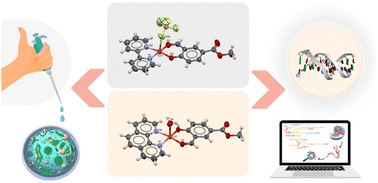Cu(ii) complexes with a salicylaldehyde derivative and α-diimines as co-ligands: synthesis, characterization, biological activity. Experimental and theoretical approach†
Abstract
Copper(II) complexes with an α-diimine show a wide variety of biological activities, such as antibacterial, antifungal, antioxidant and anticancer. In this work, we synthesized and structurally characterized two novel Cu(II) complexes with methyl 3-formyl-4-hydroxybenzoate (HL) and α-diimines: 2,2′-bipyridine (bipy) and 1,10-phenanthroline (phen). Crystal structure analysis shows that the formulas of the compounds are [Cu(bipy)(L)(BF4)] (1) and [Cu(phen)(L)(H2O)](BF4)·H2O (2), with BF4− as a ligand in complex 1, which is rarely coordinated to metals. Both complexes have a square pyramidal geometry, while DFT calculations showed that the most stable structures of complexes 1 and 2 in a water/DMSO mixture are square-planar derivatives [Cu(bipy)(L)]+ and [Cu(phen)(L)]+. The antibacterial activity of compounds was evaluated in vitro on four Gram-negative and four Gram-positive bacterial strains. Complex 2 showed greater antibacterial activity towards all bacterial strains comparable to the control compound Amikacin. Complex 2 exerted a strong cytotoxic effect against the tested cancer cell lines (IC50 values ranging from 0.32 to 0.44 μM). Both complexes caused apoptotic cell death in HeLa cells and a noticeable in vitro antiangiogenic effect. In the concentration range of 5 to 100 μM, the complexes showed the absence of a genotoxic effect and displayed a protective effect against oxidative DNA damage induced by H2O2 in human peripheral blood cells. The interaction between the compounds and calf–thymus DNA was evaluated by diverse techniques suggesting a tight binding, which was also confirmed by molecular docking. In addition, it was found that the complexes bind tightly and reversibly to bovine and human serum albumin.



 Please wait while we load your content...
Please wait while we load your content...